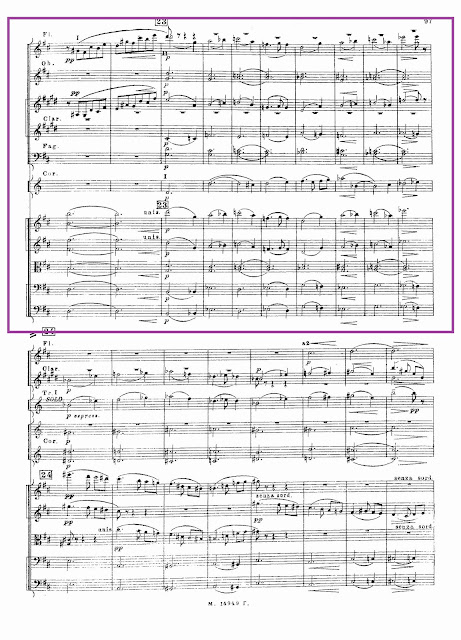CCCLXXV. MYASKOVSKY, Nikolai (1881-1950)
It is unlikely that one will leave from a hearing of this great symphony whistling any particular melody. More motivic than melodic, Myaskovsky was concerned with orchestral color, like many Russian symphonists of the period ...
With that in mind, let's take a look at some of the orchestration, which so cleverly provides the color:
First Movement
A unison theme intoned by an English Horn, two clarinets and bassoon; at Bar 7, he changes the texture by switching to two flutes, a single oboe, English Horn and two clarinets:
The thematic material is purposefully rhythmically confusing. The off-beats in the lower strings confound the 3/4 meter:
As the tempo picks up, looks how a solo oboe stands out, and then the transfer to bass clarinet:
Woodwinds alone -- first 2 clarinets, bass clarinet, and 2 bassoons; texture thickened with a flute (low register) and oboe:
Winds/strings in canon with brass:
and look how he divides the brass, so the motifs stand out:
Second Movement
B-Flat Minor. Very plaintive, Russian melody in the bassoons:
Celli in high register, all accompaniment in the same rhythm:
Again, see how Myaskovsky writes a simple line for oboe, with multiple rhythmic figures accompanying:
A brass chorale, accompanied by bass clarinet and low strings:
Reduced:
Third Movement
Allegretto molto, ma con garbo
Go get Greta!
[it means gracefully]
**
In G Minor, subdominant. The graceful melody begins in the violins, the clarinet, and the oboe.
Here he parcels out the melody to the bass clarinet, bassoons, trombones and lower strings. Three different types of background: the two 16ths-1/8th figure in the winds, off-beat half-notes in the trumpets and ascending/descending 1/8th-notes in the violins:
An example of brilliant orchestration -- first a woodwind choir, then a delicate slip of notes from the clarinet and flute above soft sul tasto strings, and then he joins them together:
The final bars are magical, ending with a soft tap on the timps:
Fourth Movement
After a fanfare-type opening with trumpet and horns; a quick pick-up by bassoon, bass clarinet, and pizzicato celli and basses, the violins begin a theme/motif that -- like much of Myaskovsky's work -- resembles previous material:
The energy is fantastic. Then he brings it all down with the celli and basses, adds winds and four bars of beautiful trombones/horns; moves it along with bassoons and trumpets and then returns with another four bars of bassoon, trombones, low trumpet and horns:
Another example of brilliant writing for solo winds, with undulating string accompaniment:
The symphony climaxes here in D Major (parallel major) with three distinct groups playing different musical material:
all ending on a unison D:





























No comments:
Post a Comment